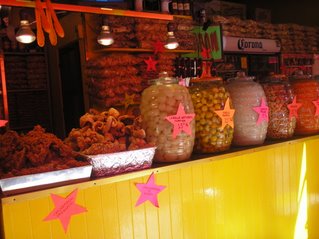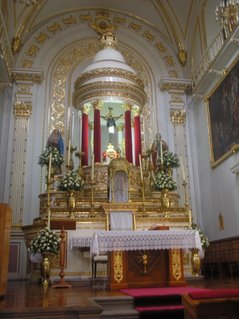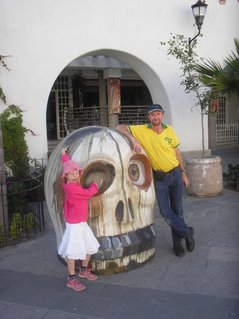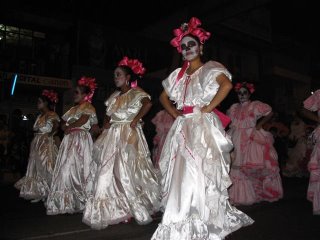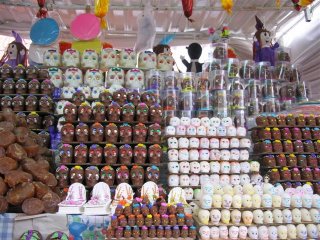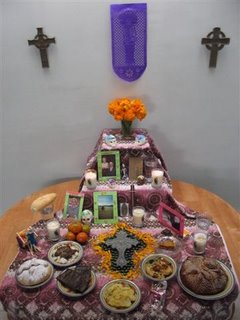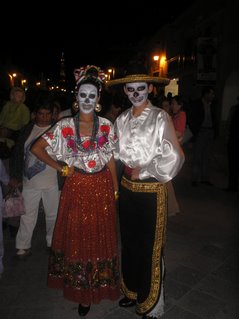
Two calaveras on opening night of
Festival de las Calaveras in Expo Plaza
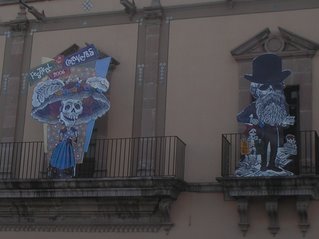
Posada's Catrina on the left and
his "self portrait"
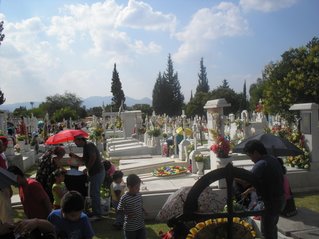
The Guadalupe cemetary on Dia de los Muertos
Dia de los Muertos is one of México’s most unique holidays. Dia de los Muertos consists of two days, November 1st beingSantos Difuntos (All Saints Day) and November 2nd being the actual Dia de los Muertos (All Souls Day or Day of the Dead). This holiday is all about celebrating, honouring, and remembering the dead. The ways in which this is done are as unique as the country itself. Many families try to adhere to traditional ways of celebrating, but Halloween has begun to intermingle with Day of the Dead thanks to México’s neighbours to the north.
After talking with a number of people and getting a variety of accounts of how the days are celebrated here, I’ll attempt to describe two common ways in which the dead are honoured.
Traditionally alters are created in each home to entice the souls of deceased loved ones to return to earth and visit their ancestral home on the night of November 1st. The idea that the souls of the dead returned to earth orginated (in México) with the Aztecs and likely pre-Aztec civilizations. They believed that life was eternal and that their time on earth was just a short stopover before the much coveted afterlife in la mas alla (the great beyond). After the Spanish conquest Dia de los Muertos was moved from its original date in late July to coincide with the Christian All Saints Day. The Day of the Dead celebrations of today are an amalgamation of Aztec and Christian traditions and ceremonies.
The alters consist of photos of deceased loved ones, brightly-coloured tissue paper cutouts, calaveras dulces (sugar or chocolate skulls), harvest foods like guavas, pumpkins and apples, pan de muerto (bread of the dead: see previous post for photo), water or other beverage that the deceased enjoyed (tequila perhaps), and marigolds which are the traditional flowers of the dead. The alter is also decorated with candles, and a cross is made from sand and marigold petals. Finally the deceased person’s favorite food is prepared and placed on the alter. Recall that the main purpose of the alter is to attract the dead. It is believed that the smell of the food accomplishes this.
Common foods placed on the alter are mole con arroz (mole sauce and rice), tamales, and enchiladas. My friend Angie (from Alberta, but now living here) specially made pumpkin pie so that she could offer a piece to her departed grandmother.
The alter in many cases is prepared several days prior to November 1st and it is believed that during the night of the 1st the souls return to taste the food. In some families the alter foods are eaten the following night though it’s said the foods’ flavour is lacking due to the souls having consumed it.
The second way that the dead are honoured is by visiting their gravesite on November 2nd. For many Mexicans November 2nd is a holiday and entire familes will visit the cemetary to clean the gravesite, decorate it with flowers, and bring offerings of food and drink. They often spend a few solemn hours sitting beside the grave. Although, we when we visited the Guadalupe cemetary we did see a small group of musicinas play lively music.
Here in Aguascalientes there is 10-day long festival to celebrate Dia de los Muertos called
Festival de las Calaveras. Calavera refers to skeleton, and though skeletons were used to symbolize death during Aztec times, the modern-day image of the skeleton in México comes from the famous artist/engraver Jose Guadalupe Posada (1852-1913). With his engravings of skeletal figures depicting every day life, Posada poked fun at death as well as providing political commentary for the times. One of his most famous images
la Calavera Catrina reminds us all that death is the great equalizer, that it touches us all. The Catrina character is a woman skeleton wearing a long fancy dress and a splendid floral hat.
Posada was born here in Aguascalientes and his images are the key artistic element of the festival indeed of Dia de los Muertos throughout Mexico.
The festival in Aguas consists of a cornucopia of events: everything from musical acts to street theatre and acrobats, to art exposions, a film festival, a parade and fireworks.
Our favorite destination during the festival was the street market near the Guadalupe church. Here we found colourful stalls selling sugar skulls, candies, nuts, Halloween costumes, plastic spiders and other plastic animals, toys, miniature skeletons in costume, marigolds, pan de muerto, tissue paper banners and other decorations. This is a key destination for people needing to stock up on items needed for decorating their alters.
This colourful and exciting festival has exposed us to some of the best of what Méxican culture has to offer. We'll never forget it.
